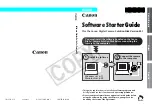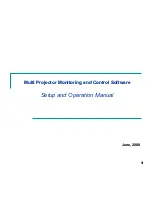
EAPS Protocol Monitoring and Verification
EPICenter Reference Guide
452
EAPS Monitor Main View
The EAPS Monitor applet provides a two-part display: a topological map view of the managed network
with respect to the EAPS protocol implementation (the EAPS map), and a set of tables showing status
information about the EAPS domains, network devices, and the EAPS-related links between devices.
The tables also provide a mechanism to navigate within the map—when you select a device or a link in
a table, that device or link is centered and highlighted on the map. When you select a domain from the
Domains table, that domain is centered and is put into Focus mode.
Figure 230
shows the EAPS applet display as it appears when first invoked.
Automatic Layout
Creates a default map layout, optimizing for node and link placement to
minimize overlap. See
“Automatic Layout” on page 460
for further
information.
ZoomIn
Expands the entire map, increasing the spacing between nodes. The style
of the node may change at different zoom levels. See
“Zooming the Map”
on page 461
for further information.
ZoomOut
Shrinks the entire map, reducing the spacing between nodes. The style of
the node may change at different zoom levels. See
“Zooming the Map” on
page 461
for further information.
Fit
Changes the map scale to fit within the visible window (viewport) while
attempting to minimize overlap. See
“The Fit Command” on page 460
for
further information.
Synchronize
Updates the EAPS status of the devices and links on the map. See
“Synchronize” on page 463
for further information.
Legend
Displays the Map Legend, which explains the symbols that appear on the
map.
Export
Exports the map layout in
svg
format, which can be imported into a tool
such as Visio.
Prints the map. Reduces the map if necessary to fit on a single sheet of
paper.
Table 44: The Map Pop-Up Menu Commands
Summary of Contents for EPICenter 6.0
Page 14: ...EPICenter Reference Guide 14 ...
Page 18: ...Preface EPICenter Reference Guide 18 ...
Page 19: ...1 EPICenter Basic Features ...
Page 20: ......
Page 24: ...EPICenter Overview EPICenter Reference Guide 24 ...
Page 44: ...Getting Started with EPICenter EPICenter Reference Guide 44 ...
Page 100: ...The Inventory Manager EPICenter Reference Guide 100 ...
Page 140: ...The EPICenter Alarm System EPICenter Reference Guide 140 ...
Page 172: ...Configuration Manager EPICenter Reference Guide 172 ...
Page 196: ...The Firmware Manager EPICenter Reference Guide 196 ...
Page 220: ...The Interactive Telnet Feature EPICenter Reference Guide 220 ...
Page 250: ...The Grouping Manager EPICenter Reference Guide 250 ...
Page 276: ...Real Time Statistics EPICenter Reference Guide 276 ...
Page 342: ...Using the VLAN Manager EPICenter Reference Guide 342 ...
Page 348: ...The ESRP Monitor EPICenter Reference Guide 348 ...
Page 446: ...EPICenter Reports EPICenter Reference Guide 446 ...
Page 447: ...2 Advanced Upgrade Features ...
Page 448: ......
Page 480: ...EAPS Protocol Monitoring and Verification EPICenter Reference Guide 480 ...
Page 508: ...Using the Policy Manager EPICenter Reference Guide 508 ...
Page 525: ...3 Appendices ...
Page 526: ......
Page 542: ...EPICenter Backup EPICenter Reference Guide 542 ...
Page 564: ...Voice over IP Manager EPICenter Reference Guide 564 ...
Page 580: ...EPICenter Reference Guide 580 ...
















































